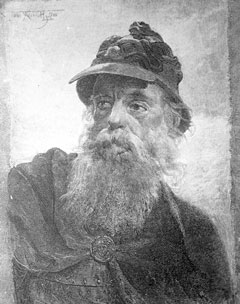Battle of Falmouth (1690) facts for kids
Quick facts for kids Battle of Falmouth (1690) |
|||||||
|---|---|---|---|---|---|---|---|
| Part of King William's War | |||||||
 Baron de St Castin |
|||||||
|
|||||||
| Belligerents | |||||||
| New France Wabanaki Confederacy |
|||||||
| Commanders and leaders | |||||||
| Joseph-François Hertel de la Fresnière Baron de St Castin Chief Hopehood (Kennebecks) Rene Robinau de Portneuf Augustin Le Gardeur de Courtemanche |
Captain Sylvanus Davis | ||||||
| Strength | |||||||
| 400-500 troops and natives | unknown | ||||||
| Casualties and losses | |||||||
| unknown | 200 killed | ||||||
The Battle of Falmouth (also known as the Battle of Fort Loyal) happened from May 16 to 20, 1690. It was a major fight during King William's War. French and Native American forces attacked an English settlement called Falmouth, which is now Portland, Maine.
The French forces were led by Joseph-François Hertel de la Fresnière. The Wabanaki Confederacy, including Mi'kmaq and Maliseet warriors, joined them. They attacked Fort Loyal, which protected the English settlers. Captain Sylvanus Davis commanded the fort. After four days of fighting, the fort surrendered. The attackers burned the settlement and the fort. Many people were killed or taken prisoner. This battle caused most Europeans to leave Maine for a long time. It also allowed Native American forces to attack other English areas more easily.
Why This Battle Happened
The first fort in Falmouth was Fort Loyal, built in 1678. It was in the middle of the town. This battle was part of King William's War. This war was fought between England and France, and their Native American allies, in North America.
In 1689, Major Benjamin Church and 250 English soldiers tried to protect settlers in Falmouth. Native Americans killed 21 of his men. But Church was successful, and the Native Americans left. Church then went back to Boston, leaving the settlers without protection.
The French Governor Frontenac chose Hertel to lead an attack in 1690. Hertel's group first raided Salmon Falls, near the Maine-New Hampshire border. After that success, they moved on to attack Fort Loyal in Falmouth.
The Attack on Fort Loyal
In May 1690, about 400 to 500 French and Native American fighters attacked Falmouth. Joseph-François Hertel de la Fresnière and Baron de St Castin led these forces. The English settlers were greatly outnumbered.
They fought for four days before they had to give up. Many settlers were killed or captured. Captain Davis, the fort's commander, was taken prisoner to Quebec. A rescue group led by Shadrach Walton arrived too late. They could not save the people from the attack.
What Happened Next
Later that summer, Benjamin Church returned to Falmouth. He helped bury the people who had died.
About 100 prisoners were taken, including James Alexander. He was taken to a Maliseet village on the Saint John River. Some prisoners, like James Alexander, faced harsh treatment. Alexander tried to escape but had to return because he was hungry. What happened to him after that is not known.
Captain Davis was a prisoner in Canada for four months. After the battle, Falmouth and another nearby settlement, Arrowsic, remained empty. No Europeans lived there again until 1714 and 1716. Fort Loyal was later replaced by a new fort called Fort Falmouth in 1742. This happened before another war, King George's War.

